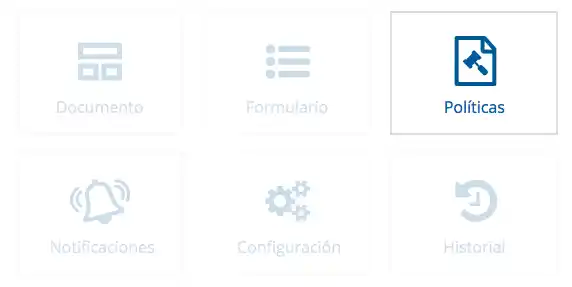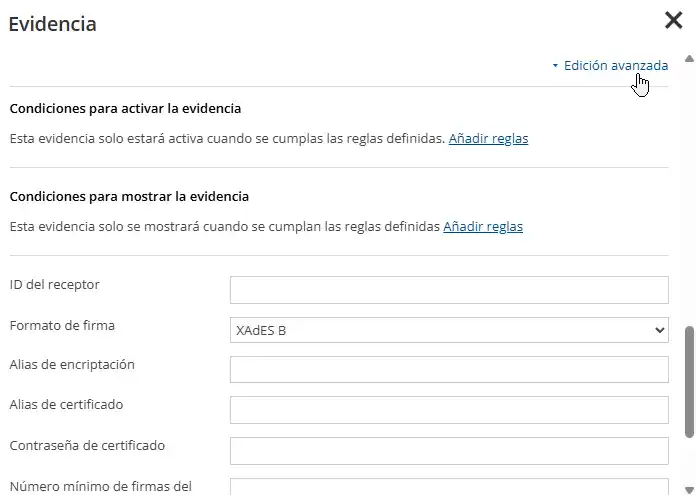When creating or editing a template from the admin panel we will find a policy section.
Policies are a set of evidence, signatures, approvals and other security elements that will determine how the PDF we send to the user should be signed.

The elements involved in a policy are as follows:
- Electronic signatures (with digital certificate)
- Unattended (on server)
- In client, using Viafirma Desktop.
- Evidencias Electrónicas
- Approvals
This functionality means that a signature request will not be completed until one or more persons (approvers) have approved the request. This approval can be given in 3 different ways:- Simple approval. This type of approval consists of simply pressing a “Approve” button. It can also be rejected.
- Approval with code. A specific code can be associated to approve the request. For this purpose, the approver will have to enter the code indicated.
- Electronic signature approval with digital certificate. A digital signature can be associated with the approval. For this, the approver will need to sign with their digital certificate in order to finalize and approve the application.
Common elements configurable in the evidence:
- ID: This identifier is automatically generated by the system for each piece of evidence, and will serve you to define validation rules.
- Tipo: Podrás cambiar el tipo de evidencia: IMAGE,SIGNATURE,GENERIC. Para las evidencias del tipo CHECK usaremos el tipo Genérica.
- Help text: Title that will appear in the actions panel, for example “Customer signature”.
- Help detail: Additional text to incorporate contextual help on evidence.
- Position identifier: If your PDF document has form fields of the type Acrofields, here you can select it, and we will use it to stamp the image associated with the evidence.
- Metadata. Depending on the type of evidence, there is a set of metadata that will help us to personalize the evidence.
Advanced edition

- Validation rules. You will be able to add validation rules for example for the use of CHECK, taking into account the value of other evidence incorporated in your policies.
- ID of the receiver. Here we can indicate the ID of the signatory to which this evidence belongs in the case of an application with several signatories.
- Signature format. Defines the signature format used for the XML where all captured data is consolidated for this evidence. The following formats are allowed: XADES-B, XADES-T, XADES-LT, XADES-LTA; XADES_T format is recommended.
- Encryption alias is optional, by default a system-defined public encryption key is used; it is only used if you want to use a different encryption key.
- Certificate alias is optional, by default a system-defined certificate alias is used for the unattended signature of the document (PDF) as well as the signature of the XML containing the evidence. If you want to use another certificate for signing, you must enter the alias here. This alias and certificate must be registered in the system.
- Certificate password is optional, by default the password of the assigned signature certificate is used. Use only if a specific alias certificate is used.
Dynamic properties
When you use the policy and evidence designer you will be able to use dynamic properties, that is, you can make use of values that you do not know yet but you can get them during the signing process, for example, from a form where you ask the user the data, or through metadata if the signing process was launched from an external system, for example a CRM, using our APIs.
For this you will only have to help of the operators {{HERE’S VARIABLE}}, and its value will be replaced automatically if in the form or in the metadata that variable is reported.